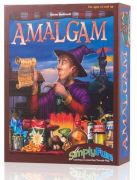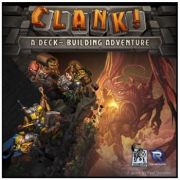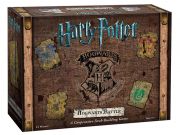Amalgam (published by Simply Fun, designed by Günter Burkhardt) – Players are wizards trying to mix potions. At the start of the game, ingredient cards are placed in a grid on the table with curved corner pieces at the four corners. Each player starts the game with their pawn at one of these corners. The goal of the game is to collect as many of the same types of ingredients as possible. Each ingredient card has a number on it. When you take a card from the grid, you place it on top of your cauldron card. On your turn you move your pawn as many spaces along the grid as the number shown on the ingredient that is currently on top of your cauldron. If you stop at the top of a row, you select one card from that row. If you stop at a corner, you get nothing. Once a card is taken from the grid, another card is drawn to replace it. Some cards won't be ingredients but are wild cards or spells. Spells give you special abilities such as forcing other players to discard their top ingredient or letting you take another turn if you end at a corner. Players continue until the draw pile is emptied and one of the rows in the grid runs out of cards. The game also includes an advanced gameplay option in which players are each dealt a recipe card at the start of the game which gives them a special goal to complete for extra points.
2017 Mensa Select Winners

After 42 hours of gaming, the Mensa Select Winners have been announced. The winners include two deck-builders, two games based on classic books, a party game, and one tricky logic puzzle about wizards brewing potions.
Around the World in 80 Days (published by IELLO and Purple Brain Creations, designed by David Parlett) – In this board game based on the classic book, players are racing against each other to be the first player to make it around the world, starting and ending in London. There are eighty spaces on the board and in order to win the game you must land by exact count on London with ten pounds or less. Each player begins the game with eighty pounds and three rumor cards which they must get rid of before the end of the game. On your turn you use pounds to move, choosing how many spaces you wish to go. Each player has a sheet that shows how much it costs to move each number of spaces. Different spaces you land on have different effects. Some will make you draw cards, some of which can help you while others can harm you. Other spaces will allow you to discard rumor cards or earn you money. There are also red spaces on the board. On your turn you can choose to move back to the nearest red space, earning money for each space you've moved in order to reach it.
Clank!: A Deck Building Adventure (published by Renegade Game Studios, designed by Paul Dennen) – Players are exploring a dungeon in this deck-builder card and board game. Players begin the game with a base deck of cards, some of which will give them experience points to buy more cards while others will give them combat to fight monsters or movement points which they can use to move their pawn around the board. Some paths between locations will require extra cards, force you to fight monsters, or may even require a key that you can buy at the market from the center of the board. Players collect items around the board, trying to gather coins and victory points. Players must also acquire a special artifact. Without one, you cannot win the game. Some things will also give you clanks, which means you have to place one of your colored cubes into the Clank area. Various cards and items will cause the dragon to move and when this happens, he attacks and all the clank cubes are put into a bag and a certain number drawn. If your cube is drawn you take damage and if you ever lose all your hit points your character dies if you are too deep in the dungeon — or, at best, you are rescued by villagers but not able to explore the dungeon any further. Once you think you have enough points, you can race for the dungeon exit, where you can begin the process of bringing the dungeon down, killing all the other players if they don’t make it out in time.
Harry Potter Hogwarts Battle (published by USAopoly, designed by Forrest-Pruzan Creative) – This cooperative deck builder uses images from the Harry Potter film series. In order to win the game, players must defeat all the villains. You lose if the villains take over all the locations. At the start of each turn, a certain number of dark arts cards are drawn. These can do things such as take health away from one or more players or add a dark arts control token to a location. Players then check the villains that are currently out on the table to see if any of their abilities activate and then a player can take her turn. Each player begins with a special deck of starting cards that are different based on which character they are playing. Cards can give you health, power, or money. With power, players attack the villains while money allows you to buy more Hogwarts cards to make your deck more powerful. The game comes with seven boxes, one for each book in the series. Players begin with the first box and once they beat that, they open the next, introducing more cards to all the decks, increasing the difficulty, and gaining new powers.
Imagine (published by Gamewright, designed by Shotaro Nakashima) – In Imagine, players take turns drawing a card and choosing a word off of it. There are many clue cards. Each clue card is clear with an image on it. These cards can be overlaid on top of one another in order to create images and pictures. The player with the word uses as many of these clues as they choose in any way they want to try and get the other players to guess what their word is. There is no set time limit and players can either agree on one at the start of the game or simply give the clue giver as much time as he wants. Once someone guesses the word, both the clue giver and the guesser earn a point.









